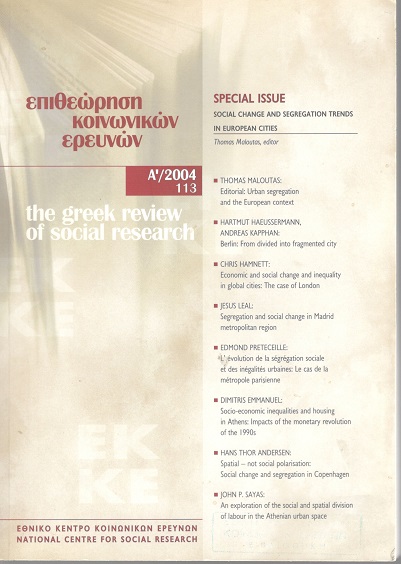Urban sprawl in the periurban coastal zones of Athens
Abstract
Urban sprawl has for quite a long time been a central issue in urban and regional analysis and planning practice. Most of the theoretical and empirical work however, has focused on urban sprawl in North European and North American city regions. Recent work has brought to the fore some of the crucial differentiating elements of Southern European, Mediterranean, urban settlement structure. The history of spatial development in the European South and in particular in the Mediterranean basin has often been characterized as “idiosyncratic”. A settlement space characterized by a small number of large scale urban-industrial agglomerations, and a plurality of agricultural rural areas, extensive internal and external migration, coupled with an increasing concentration of popular tourist destinations. In these latter areas, issues like “coastalization”, “tourist urbanization” of periurban coastal zones have come to the forefront of urban sprawl analysis and policy-making. The paper argues that there is a need to develop novel conceptual and methodological tools, in order to understand, explain and plan for these “urban sprawl” aspects of the Mediterranean periurban regions. The changing socio-spatial facets of the settlement development process in these areas are investigated by focusing primarily on the changing population and housing distribution as well as on the composition of land use patterns and the evolution of the socio-professional structure of the resident population. The main observation is that in the wider Athens area the bulk of the population and of the build up area is concentrated in the central urban quarters and their immediate neighbours; there are, however, strong indications of a “sprawling” process, filtered through a rapidly emerging and highly commodified private housing market. The latter affects mainly the Northeastern part of the urban edges and coastal areas. The coastal areas of the region are being transformed from “vacation” areas, which were, by and large, the outcome of “spontaneous” housing provision mechanisms, to primary residential ones, usually the outcome of a highly standardized and commercialized housing market. The observed population shift is stronger among “higher” social strata. The urban social matrix though does not become any simpler as a result.
Article Details
- How to Cite
-
Sayas, J. P. (2016). Urban sprawl in the periurban coastal zones of Athens. The Greek Review of Social Research, 121, 71–104. https://doi.org/10.12681/grsr.9569
- Section
- Articles

This work is licensed under a Creative Commons Attribution-NonCommercial 4.0 International License.
Authors who publish with this journal agree to the following terms:
- Authors retain copyright and grant the journal right of first publication with the work simultaneously licensed under a Creative Commons Attribution Non-Commercial License that allows others to share the work with an acknowledgement of the work's authorship and initial publication in this journal.
- Authors are able to enter into separate, additional contractual arrangements for the non-exclusive distribution of the journal's published version of the work (e.g. post it to an institutional repository or publish it in a book), with an acknowledgement of its initial publication in this journal.
- Authors are permitted and encouraged to post their work online (preferably in institutional repositories or on their website) prior to and during the submission process, as it can lead to productive exchanges, as well as earlier and greater citation of published work (See The Effect of Open Access).




